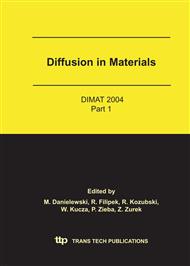p.578
p.584
p.593
p.603
p.609
p.621
p.635
p.647
p.653
Atomic Migration as a Mechanism of Superstructure Formation in Intermetallic Compounds
Abstract:
“Order-order” relaxations driven by atomic migration in superstructures proceed in nonsteady- state of a system, which relaxes to the equilibrium atomic configuration. Hence, the corresponding studies are complementary to standard steady-state diffusion investigations. Two time scales operating in “order-order” relaxations in L12-ordered (Ni3Al) and L10-ordered (FePd, FePt) binary intermetallics were experimentally observed. On the other hand, in B2-ordered NiAl – known of a giant vacancy concentration, “order-order” relaxations appeared surprisingly slow. Definite relationships between the activation energies for diffusion ( ) D A E and “order-order” relaxations ( ) O O A E − were revealed: ( ) D A E < ( ) O O A E − in L12-type superstructure; ( ) D A E ³ ( ) O O A E − in L10- and in B2-type superstructures. Corresponding simulation studies elucidated the specific atomistic mechanism of the processes. It has been shown that different time scales active in “order-order” relaxations in L12 and L10-ordered systems follow from specific atomic-jump correlations, which result from non-steady-state conditions and particular superlattice geometries: the availability of easy diffusion channels. A model of “order-order” kinetics in NiAl as controlled by a triple-defect mechanism is proposed.
Info:
Periodical:
Pages:
609-620
Citation:
Online since:
April 2005
Price:
Сopyright:
© 2005 Trans Tech Publications Ltd. All Rights Reserved
Share:
Citation:


